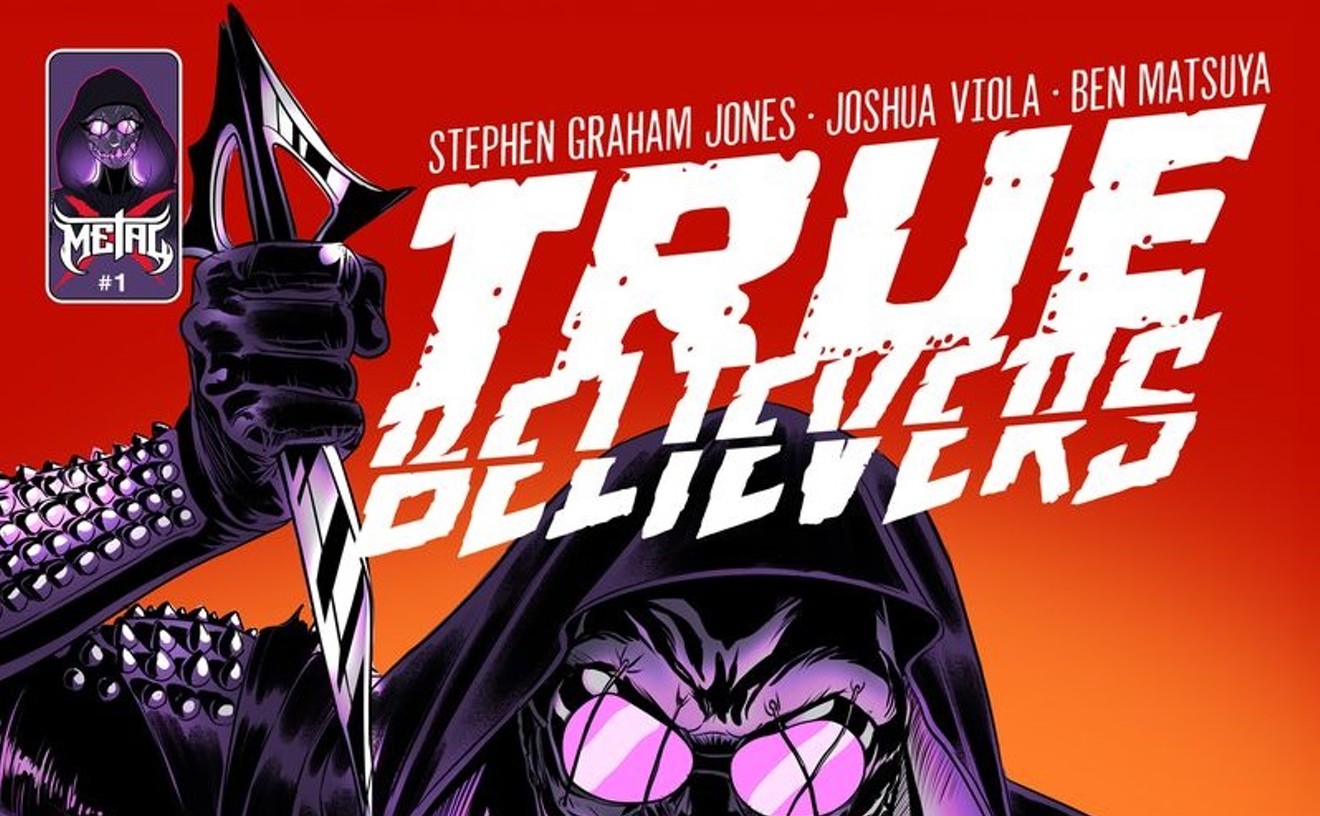"Los Supersonicos is a grupo," says Carlos Fresquez, who teamed with Francisco (Frank) Zamora for the collaboration. A well-known Denver artist, Fresquez has been interested in artistic cooperation for a long time. In the early 1990s he joined two other high-profile local artists, Tony Ortega and Carlos Santisteven, to form the short-lived Los Three. The group's works commented on Chicano culture, but Fresquez now describes his style at the time as "conservative and romantic." These are two qualities in short supply in Los Supersonicos, which is instead daring and cynical.
Fresquez has exhibited frequently over the last two decades; his accomplished work has been shown in more than a dozen solo shows as well as scores of group offerings. He imbues his work with his experience as a "Chicano," a term he uses pointedly. "We're disappearing," he says. "First 'Chicano' was replaced by 'Hispanic,' and then by 'Latino'--we're losing our identity, man." "Chicano" specifically refers to Mexican-Americans born in the United States, whereas "Hispanic" and "Latino" carry broader meanings. Fresquez defines himself as Chicano because, though he is a fourth-generation Coloradan descended from a family who lived in Santa Fe, New Mexico, for centuries, he is nonetheless steeped in the unique variant of Mexican culture that still flourishes in Denver and throughout the Southwest. But Fresquez doesn't just look back wistfully at his heritage; he also takes in current events. His last two exhibits, Lagrima/Teardrop and Cholodelica, explored the Chicano gang culture in Denver. Both of these strong shows were presented at the Edge Gallery, where Fresquez is a co-op member.
The idea for Los Supersonicos, both the group and the exhibit, came to Fresquez when he first saw the work of emerging artist Zamora last year in La Mano Peluda, at Denver's Chicano Humanities & Arts Council. "I couldn't believe it," he says. "I met Francisco, saw his work, which was quirky and strange. He was doing something that was exactly the opposite of what I'd been doing. In my work, each element had to have a meaning, but Francisco's work had no meaning--it was just shapes, forms and colors."
Despite his attention to picture design, Zamora does not paint abstracts but rather employs a kind of neo-pop art, since he also uses imagery from popular culture, including cartoon characters. Zamora, who was born in Colorado, lives part of the year in Commerce City and part of the year in Mexico City, where he is now.
The name Los Supersonicos refers to the future. It's the name used in Mexico for the Jetsons cartoon. "Los Supersonicos is a tiempo trip into the future, with flying saucers, aliens--and maybe even some illegal aliens," says Fresquez with a laugh. "We're all from the same planet, so how come some people are called aliens?" This interest in the future reflects the fact that Fresquez aims with Los Supersonicos to break the stranglehold traditional representational styles have had on mainstream Chicano art since the 1960s. "What's the future of Chicano art? It needs to be kicked in the ass," says Fresquez, complaining that the same images and approaches have been used over and over. "An artist friend of mine says that maybe we've set the bar too low for Chicano art if everyone can clear it. I want to raise the bar with my work."
The show begins with "Tacuche Haze," a small piece done by both Fresquez and Zamora. The square panel is carried out in mixed mediums, including paint and collage elements. On a smeared painted ground accented with pink, purple and green, a dark-blue silhouette of a 1940s zoot-suiter (called a pachuco) is set next to a photo of a young man stripped to his briefs. The nearly nude man, whose arms are crossed against his stomach, is apparently embarrassed. His image relates to the strip-searching of pachucos by the Los Angeles police that was common practice in the 1940s. "Tacuche Haze" is sharp politically and aesthetically, a combination that's not easy to accomplish.
Nearby are four collaborations closely related in size and content to "Tacuche Haze." One of the most striking is "Picoso Hot and Fast" in paint and collage. The title is a play on words: Picoso means "hot" in Spanish, but it also sounds like the name of Picasso, the greatest artist of the century and a Hispanic. Fresquez and Zamora place a hand-painted copy of Picasso's famous self-portrait as a bull on an abstract-expressionist field of yellow, pink and teal. In the bottom left quadrant is the easy-to-recognize flying saucer from The Jetsons.
The two artists also collaborated on a pair of painted sculptures. In "El Templo de la Raza Cósmica," they constructed a Meso-American pyramid and covered it with images from Mexican history and contemporary culture. The pyramid is surmounted by a reproduction of a Mayan statue wearing a Mickey Mouse mask. The source for this sculpture is the notion of the "Raza Cosmica," or cosmic race. The idea derives from Mexican anthropologist Jose Vasconcelos, who believed that the modern Mexican was heir to all the races in the world, which, in coming together, created a new, cosmic race. Fresquez painted each side of the pyramid's cap a different color to represent the four dominant races of Mexico--yellow, red, black and white.
The other sculpture is "For the Punk Psychedelic Mariachi," a cubist rendition of a guitar covered with images, most importantly a nearly hidden photo of mid-century Mexican artist Frida Kahlo that Fresquez has defaced with a mustache. The graffiti mustache is reminiscent of "L.H.O.O.Q.," Marcel Duchamp's 1920s defacement of a reproduction of da Vinci's "Mona Lisa." But it also refers to the fact that Kahlo actually had a mustache, which she carefully recorded in several self-portraits.
Humor is the key to Fresquez's individual works, which make up much of the rest of the show. "Tortilla, Hecho en Aztlan" is a portfolio of twelve screen prints depicting tortillas with their burn patterns altered to create recognizable images. In "Wanna Piece (Peace Symbol)," it's the peace sign; in "Have a Maize Day (Happy Face)," its that ubiquitous drawing of a smiley face in a circle. The happy face shows up again in "Tiempotrippin," where Fresquez has drawn it in red paint on cheap plastic versions of the Aztec calendar. "People have complained that I have desecrated the calendar, but it's already been desecrated by being turned into cheap tourist junk sold on the border," says Fresquez.
The stunning diptych "Los Manos Que Curan" is an important painting in oil on wood with milagros and a holy-water container. The painting shows Spaniards cutting off the hands of Indians. Also strong are the two mural-sized paintings--"Yellow Wall; West," in oil on board, and the monumental acrylic on canvas "Corridocosmico." Employing the same all-over composition as "Corridocosmico" is "Ma' Gritoflintt v.," an acrylic on canvas.
Zamora also displays solo works. "El Fin," an acrylic on canvas, features the phrase " El Fin" (The End) set in the center of a hard-edged lineal pattern based on traditional Mexican weaving. This reference to weaving is also seen in "Pinocho," another acrylic on canvas, in which Zamora pairs Disney's Pinocchio with the head of Christ. He first saw the juxtaposition on a bus in Mexico that had been decorated by its driver.
Los Supersonicos is not all good. Some of the Fresquez-Zamora combination pieces--such as "afreeformfunkifiedplacadelic," a twelve panel painting with movable sections--are a mess. But there's no arguing with their goal: to bring Chicano art into the 21st century.
Since 1972, the Savageau Gallery on East Colfax Avenue has specialized in the history of Colorado art, which makes director Steve Savageau a trailblazer in the burgeoning field. The current exhibit, The Colorado Pioneer Art Show, which closes Saturday, includes a wide assortment of paintings and works on paper by some of the best-known names from the state's illustrious past. Sadly, though not surprisingly, nearly every artist represented in the show is now deceased.
Colorado Pioneer was installed in the so-called library style, in which works of art are hung floor to ceiling. This dense installation has been made more confusing by its specific arrangement, since the pieces have been placed with no apparent rhyme or reason. Traditional paintings hang side by side with modern ones. But this is a minor complaint, as Colorado Pioneer has many worthwhile things rarely seen outside of private or institutional collections.
Ignoring the free association of the hanging, Colorado Pioneer could be seen as two distinct shows, a landscape exhibition and one devoted to old abstracts. Among the best landscapes are several early-twentieth-century watercolors by John Edward Thompson and the 1901 impressionist oil painting "In Southern Colorado," by Harvey Otis Young. Standouts among the abstracts are the 1960s palette-knife paintings by Charles Bunnell, notably "Composition in Red and Blue," an oil on paper, and the group of cubistic oil-on-panel compositions by Paul K. Smith.
Historical exhibits such as this one reveal that art has a long tradition in our state, one to which the contemporary scene owes a big debt of gratitude.
Here's fair warning: The Poindexter Collection of Modern American Masters, one of the most significant shows in memory, closes this Sunday at the Denver Art Museum after a glittering seven-month run. The exhibit highlights a group of small but significant paintings from the Montana Historical Society that survey the most important currents in abstract painting in America during the 1940s and 1950s. It was put together by George Poindexter, a New York millionaire who originally hailed from Montana. It was given to the MHS three decades ago in honor of Poindexter's father, Joseph Boyd Poindexter, much to the consternation of the rest of the family, who didn't fully appreciate the value of those newfangled abstractions. Nor did the MHS: Prior to the current display at the DAM, the collection had not been exhibited in more than thirty years.
The show is installed in the Close Range Gallery (recently redubbed the Vance Kirkland Close Range Gallery), where it is too crowded--but what divine clutter. Poindexter was broadly interested in modern art. He hunted down characteristic and already hard-to-find work by many of the most prominent artists of his time. He collected not only the work of the New York abstract-expressionist masters, as expected, but he also bought paintings by figural abstractionists working in the San Francisco Bay area and sampled the color-field painters from Washington, D.C.
There are many highlights in this crowded treasure trove. Particularly fine is the marvelous 1951 untitled oil painting by Franz Kline. It's classic Kline, with black slashes across a white ground. There are four important and early Willem de Kooning paintings, including the remarkable "Woman," done in 1946. Jackson Pollock, Richard Diebenkorn and Gene Davis are also represented.
The closing of the Poindexter is doubly sad. Not only will the hoard be carted back to the basement storerooms of the MHS, but the closing is the last curtain call for Nancy Tieken, the former DAM adjunct curator who organized the show. Tieken now lives in Boston and will never again grace the DAM with the high-quality exhibits that were her signature.
Los Supersonicos: Two Chicanos Zoom Into the New Millennium, through May 22 at the Museo de las Americas, 861 Santa Fe Drive, 303-571-4401. The Colorado Pioneer Art Show, through May 15 at the Savageau Gallery, 2230 East Colfax Avenue, 303-355-6101. The Poindexter Collection of Modern American Masters, through May 16 at the Denver Art Museum, 100 West 14th Avenue Parkway, 303-640-2295.










